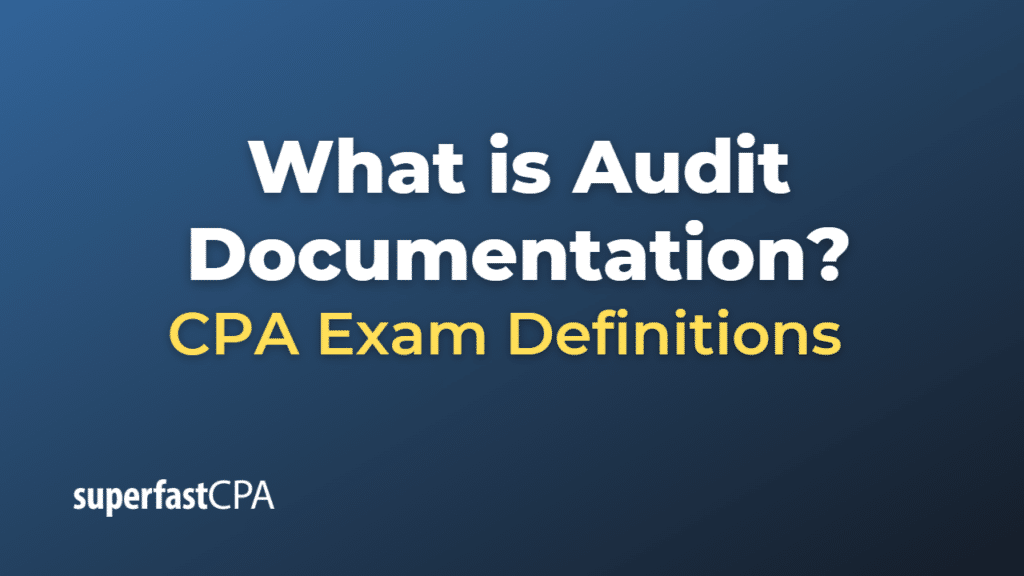Audit Documentation
Audit documentation refers to the written records and supporting materials collected and prepared by an auditor during an audit engagement. These records serve as evidence of the auditor’s basis for conclusions and provide support for their audit opinion on the financial statements. Audit documentation includes working papers, memos, and correspondence related to the audit procedures performed, findings, and conclusions.
The purpose of audit documentation is to:
- Provide evidence of the auditor’s work, supporting the basis for their conclusions and the audit opinion.
- Help plan, perform, and supervise the audit by serving as a record of the audit procedures applied, the results obtained, and the conclusions reached.
- Enhance the quality and consistency of the audit by facilitating the review and supervision of the audit work by other members of the audit team, engagement quality control reviewers, or external regulators.
- Demonstrate compliance with auditing standards and other applicable legal and regulatory requirements.
Audit documentation typically includes:
- Audit planning documents, such as audit strategy, risk assessment, materiality calculations, and audit scope.
- Audit program, outlining the detailed audit procedures to be performed.
- Working papers that document the procedures performed, evidence obtained, and conclusions reached, including copies of key financial records, client correspondence, and auditor’s notes and analyses.
- Summaries of significant findings, issues, and resolutions.
- Internal control documentation, including flowcharts, narratives, or questionnaires.
- Reports or communications with the client, such as management letters or representation letters.
- Final audit report and supporting documentation for the auditor’s opinion.
Audit documentation should be clear, concise, and organized to facilitate understanding and review by other members of the audit team or external regulators. The documentation should be retained for a specific period, usually several years, as required by the applicable auditing standards and legal and regulatory requirements.
Example of Audit Documentation
Let’s consider an example of audit documentation for a hypothetical company, ABC Corporation.
ABC Corporation is a manufacturing company, and an external auditor is engaged to perform an audit of its financial statements for the fiscal year ending December 31, 20XX. The audit documentation for this engagement could include the following:
- Audit planning documents:
- Engagement letter outlining the terms and scope of the audit.
- Audit strategy outlining the overall approach, key risks, and areas of focus.
- Materiality calculations based on a percentage of revenue, net income, or total assets.
- Risk assessment, including identification of significant accounts and relevant assertions.
- Audit program:
- Detailed procedures for testing revenue recognition, including the review of sales contracts, and testing of sales cutoff procedures.
- Procedures for testing inventory valuation, including physical inventory observation, testing of inventory costing methods, and assessment of obsolescence.
- Working papers:
- Copies of bank statements, invoices, and other financial records reviewed during the audit.
- Spreadsheets and calculations supporting the auditor’s analyses, such as aging of accounts receivable or testing of inventory valuation.
- Auditor’s notes and memoranda documenting discussions with management, explanations for variances, and other observations.
- Summaries of significant findings:
- A summary of identified control deficiencies, with recommendations for improvement.
- A summary of unadjusted differences, including items that were identified but not corrected by management, with an assessment of their impact on the financial statements.
- Internal control documentation:
- Flowcharts or narratives describing the company’s processes for sales, purchasing, and inventory management.
- Control testing results, including walkthroughs and tests of operating effectiveness.
- Reports or communications with the client:
- Management letter outlining any control deficiencies or recommendations for improvements.
- Representation letter from the client’s management confirming the completeness and accuracy of the information provided to the auditor.
- Final audit report:
- The independent auditor’s report containing the auditor’s opinion on the financial statements.
The audit documentation for ABC Corporation would be organized, clear, and concise to allow for a proper understanding and review by the audit team and external regulators, if necessary. The documentation would be retained for the required period specified by the applicable auditing standards and legal and regulatory requirements.













